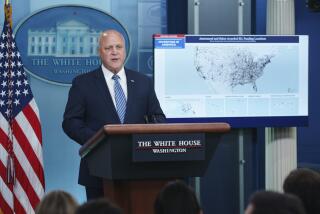Wireless airwaves would double under Obama plan
- Share via
Reporting from Washington — President Obama signed a memorandum Monday that would double the current amount of airwaves available for wireless devices over the next 10 years, a move intended to create jobs and boost investment in the mobile phone market.
The availability of more wireless spectrum will allow faster delivery of data and video onto smart phones and other next-generation devices.
The memorandum calls for 500 megahertz of government and commercial spectrum to be made available over the next 10 years. The Federal Communications Commission made the same recommendation in its National Broadband Plan released in March. In the nation’s largest cities, such as New York and Los Angeles, local TV stations use only about 150 MHz, according to the FCC’s National Broadband Plan.
“The initiatives endorsed today will spur economic growth, promote private investment and drive U.S. global leadership in broadband innovation,” FCC Chairman Julius Genachowski said. “Spectrum is the oxygen of wireless, and the future of our mobile economy depends on spectrum recovery and smart spectrum policies.”
Rep. Edward J. Markey (D-Mass.) said Monday that he would introduce a bill to make the 500 MHz available.
Wireless telecommunications companies will be able to acquire some of this public spectrum in a government auction. Some of the revenues will be used to create a nationwide public safety network that is intended to keep communications running in an emergency, which was a recommendation of the 9/11 Commission.
With the rising popularity of smart phones, netbooks and other wireless devices, the amount of data sent over wireless networks is higher than ever and continues to grow each year. Because of this, wireless phone companies need more spectrum to accommodate this glut of data and avoid a “spectrum crunch,” White House economic advisor Lawrence H. Summers said.
“In recent years, the amount of information flowing over some wireless networks has grown at over 250% per year,” Summers said in a speech Monday at the New America Foundation, a Washington think tank. “There is no policy step more important for the digital infrastructure than assuring that scarce spectrum is efficiently allocated.”
Wireless companies, including AT&T and Sprint Nextel Corp., lauded the administration’s plan, saying it would help them manage the deluge of data traveling across their networks. AT&T Senior Vice President Jim Cicconi called the move “both encouraging and timely.”
“At AT&T, we are already dealing with phenomenal increases in mobile broadband use — a whopping 5,000% over the last three years,” Cicconi said.
Broadcasters, however, weren’t as enthusiastic. The federal government will look to local TV broadcast stations to give up some of their airwaves, which they won’t relinquish easily. The FCC’s National Broadcast Plan called for local broadcasters to make 120 MHz of their spectrum available.
“We appreciate FCC assurances that further reclamation of broadcast television spectrum will be completely voluntary, and we’re convinced that America can have both the finest broadband and broadcasting system in the world without jeopardizing the future of free and local TV service to tens of millions of viewers,” said Dennis Wharton, executive vice president of the National Broadcasters Assn.






